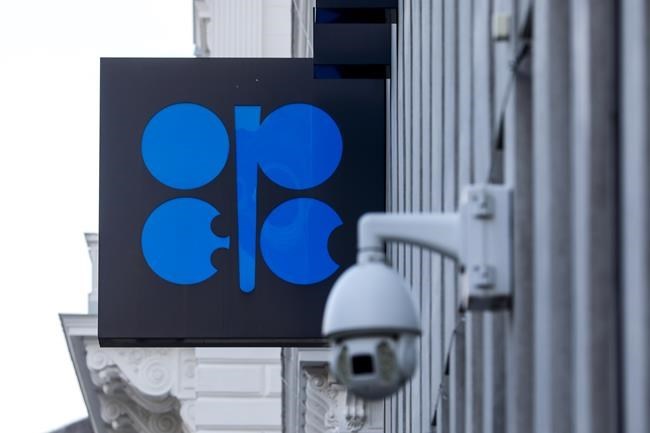LONDON (AP) — The OPEC oil cartel led by Saudi Arabia and allied producers including Russia made at propping up lagging crude prices Thursday, expanding some output cuts into next year and bringing up-and-coming oil supplier Brazil into the fold.
Lower oil prices have been a good thing for U.S. drivers, who have been able to in recent months. But it’s bad news for OPEC+ countries whose oil income bolsters their economies and who have faced setbacks in pushing prices higher despite initial fears that the .
The OPEC+ oil ministers came out of an online meeting with more than 2 million barrels per day in voluntary cuts through the first three months of next year and declared that Brazil would join the bloc in January, bringing one of the world’s fastest-growing oil producers into an alliance that is trying to rein in global supply.
However, sweeping cutbacks from OPEC+ and individual member countries since October 2022 have not made lasting changes to oil prices because of concerns about too much crude circulating in a , which could weigh on the thirst for oil for travel and industry.
The market even shrugged off the new move, though it amounts to roughly 2% of global supply.
Jorge Leon, senior vice president of oil market research for Rystad Energy, called it a “bit of disappointing meeting” for OPEC+ and a “bittersweet” one for Saudi Arabia in particular because it couldn't convince the whole group to commit to production cuts.
The market also was let down, because it “was likely expecting a deal covering the first half of next year," he said.
Other energy experts saw the oil bloc's two-part solution for a lagging market more positively. Paul Tossetti, an executive director of S&P Global Commodity Insights, praised the “imaginative ways” of OPEC+ lately in dealing with market challenges from the Americas, climate change efforts and on other fronts.
Taken together, the bloc's two moves Thursday serve to “preserve the unity of the group at a challenging time,” Bhushan Bahree, another executive director at the group, wrote.
Saudi Arabia led the deepening voluntary cuts Thursday, extending its through March. It was followed by Russia, which is cutting 500,000 barrels per day of crude and refined oil products, and then Iraq, the United Arab Emirates, Kuwait, Kazakhstan, Algeria and Oman with smaller amounts.
Russia wants higher oil prices to boost the against Ukraine, while the Saudis have to earn nearly $86 per barrel to meet their planned spending goals, according to the latest estimate from the International Monetary Fund.
Saudi Arabia is trying to fund an ambitious overhaul of the kingdom’s economy, reduce its dependence on oil and create jobs for a young population.
But the international benchmark Brent crude has stayed in the low- to mid-$80 range in recent weeks and fell more than 2% to $80.91 a barrel following the meeting before settling at $82.83 Thursday. U.S. crude also dropped 2.5% to $75.90 before settling at $75.96 per barrel.
The expanded cuts were expected to keep crude prices in the same range of $80 to $85 a barrel for the first half of the year, Leon said.
Lower oil prices have allowed U.S. gas prices to fall or stay steady since Sept. 19, AAA said. Gas is averaging just below $3.25 a gallon, the motor club said, down about 7% from a month ago.
But that's still higher than when President Joe Biden took office in January 2021, when prices were averaging about $2.40 a gallon. for Biden going into the 2024 election, prompting him to say this week that and reduce price pressures are a priority.
“President Biden is focused on prices for American consumers, which have been coming down steadily,” the White House said in a statement Thursday after the OPEC+ meeting.
U.S. oil production as OPEC+ has cut back, with producers outside the group expected to keep leading global growth in oil supply next year, the International Energy Agency said.
For instance, daily production in the U.S. averaged 13 million barrels a day in August, an increase of more than 1 million barrels from a year ago, according to the latest monthly figures from the U.S. Energy Information Administration.
The risk is growing that production cuts could reduce the influence of OPEC+ over oil supplies as other countries boost their output.
“The kingdom is balancing the desire to keep prices high by limiting supply with the knowledge that doing so will lead to a further drop in overall market share,” Leon said.
Bringing in Brazil, which the IEA also said has been producing record amounts of oil this year, would give the 23-member OPEC+ a leg up.
Adding Brazil's oil would bring the amount of global production controlled by OPEC+ up to 62%, similar to the share held by the organization when Russia joined in the mid-2010s, Leon said.
José Chrispiniano, press secretary for President Luiz Inacio Lula da Silva, said the invitation was under analysis.
___
Knickmeyer reported from Washington. AP writers Mauricio Savarese in São Paulo and Aamer Madhani in Washington contributed.
Ellen Knickmeyer And Courtney Bonnell, The Associated Press



